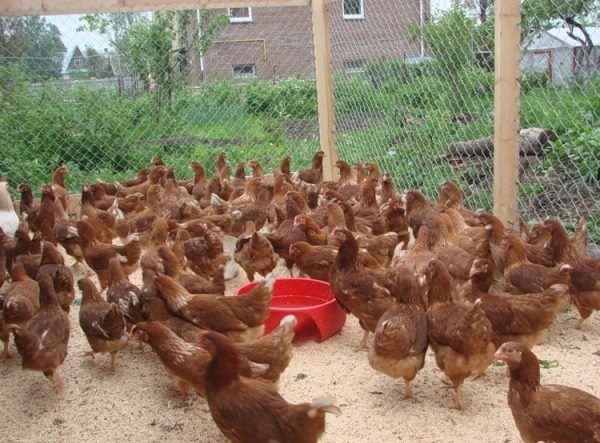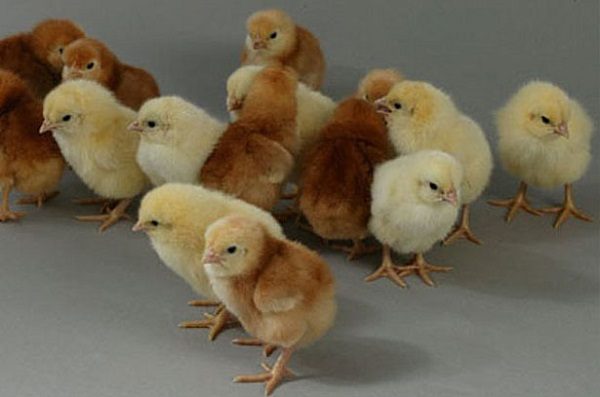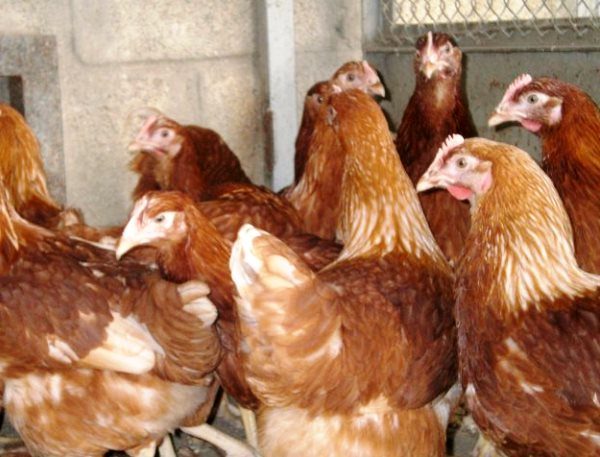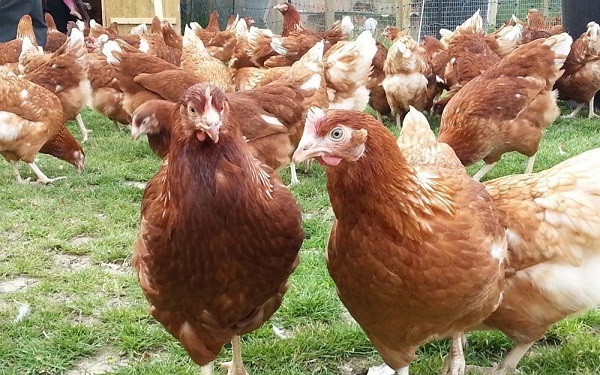Chickens are the most popular variety of poultry, the maintenance, breeding and selection of which a person has been engaged in for thousands of years.
One of the breeds of these domestic birds that are popular in Russia is the hens Rhodonite, bred relatively recently at the Sverdlovsk poultry-farming factory in 2002-2008. In this article we consider the description and characteristics of chickens and hens rhodonite.
Table of contents
Hens of rhodonite: characteristics and description
For breeding the breed of chickens Rhodonite 3, the Rhode Island roosters and the specimen Loman Brown on the maternal line were used. In this connection, the variety obtained during breeding has features of both species.
The breed is distinguished by a medium-sized head, a yellow beak with a strip in the middle and large earrings of bright red color and a crest of a leaf-shaped form. The plumage, tight to the body, has a light brown color with off-white patches on the ends of the feathers in the area of the wings and tail.
Temperament and content features
Rhodonite is distinguished by its mobility, high degree of activity, lack of aggressiveness, adaptability.
Suitable for both industrial breeding and for breeding in a small household farm. One of the features of the breed is the unpretentiousness and adaptability of chickens, which allows for the maintenance of their usual house without insulation of the perimeter. This breed tolerates temperature fluctuations, but to increase egg production in winter, the house should not be colder than 2 degrees below zero.
Increased temperatures above 28 degrees in the summer are also factors that reduce egg production.It is recommended to keep the house clean at home by periodically disinfecting the walls and ceiling by whitewashing the room. In the conditions of the poultry farm, the density should not exceed 20 heads per area of 10 square meters.
Layer rhodonite: weight and egg production
There are five types of chick division:
- Egg breeds.
- Egg and meat.
- Broiler chickens.
- Decorative rocks.
- Fight
Rhodonite belongs to the egg type. Although many breeders grow this species, including for meat. For the year, females can carry about 300 pieces of eggs, and the egg-laying period starts from four months of age.

Eggs are relatively small, weighing about 60g. Dark brown eggshell. The highest degree of egg production is observed in the first half to two years. It is noteworthy that there is a special vaccine that can increase the reproductive performance of a middle-aged layer to its original levels by about 80 weeks.
Breed distinguish small weight.Hens of hens rhodonite reach a body weight of approximately 2 kg, on average, roosters weigh about three. The skeleton of a bird is characteristic for layers, differs in compactness and ease of bones. Chickens are easily distinguished by gender in the first day of life:
- The color of the yellow males' down, in the hens the down is brown.
- For cockerels dark circles around the eyes are characteristic, and in the hens they are light.
Feeding
They feed the poultry with combined feed and mash with the addition of fish or meat broth. In addition to animal feed, wheat or wheat groats can be given as dry food. Minerals and vitamins must be present in the ration of Rhodonite, therefore even in the winter period it is recommended to use vegetables and dry greens (nettle) to make mash.
As a source of calcium, ground shells or egg shells, chalk or limestone are given, since the absence of calcium in the diet leads to thinning of the eggshell in the hens, or even its complete absence. To improve the digestion in food, chickens are mixed with small stones or gravel. Chickens from the first to the eighth week of life are fed with combined feeds PC-2, with the transition to PC-4 after reaching young animals of eight weeks of age.
In terms of feed costs, Rhodonite Cross is distinguished by a slightly higher degree compared to other common varieties of egg breeds. Thus, the average cost of feed per head is about 42 -43 kg for 18 months, while the cost of feed per 10 eggs is approximately 1.36 kg or 2.10 kg of feed per kilogram of egg mass.
Breeding breed
Due to the fact that the laying instinct is extremely poorly developed, brooding of rhodonite chickens requires the presence of an incubator. Specialists recommend the purchase of chicks on large poultry farms.
Due to the high survival rate of young stock, this method is most appropriate. But even when choosing a breeding method for rhodonite, buying at least one rooster in the flock is still necessary through the purchase of chickens. Actually, the presence or absence of a rooster does not affect the level of egg production, however, according to the advice of experienced breeders, the presence of a male helps to observe a kind of discipline in the house.

Diseases and treatments
Like other birds, rhodonite chickens can sometimes get sick.Bird health is an indispensable guarantee of high egg production. One of the most important conditions for this is keeping the house clean with timely disinfection and optimal feeding with saturation of the body with the necessary complexes of vitamins, minerals and nutrients.
Less susceptible to chickens:
The body of chicks is most susceptible to diseases. However, adults can also suffer from a number of diseases that can lead to a deterioration in the well-being of birds, as a result, to a decrease in egg production or even mortality of birds in severe cases. Here are some diseases that chickens rhodonite may be subject to, including cross rhodonite:
- Pullorosis. The disease affects young animals less than two weeks old. Symptomatic - let down wings, eyes closed, lack of appetite. Death is inevitable.
- Pasteurellosis. Chicks are sick mostly younger than 3 months. The main symptoms of the disease are frothy mucous nasal discharge, hyperthermia, yellow feces.Treatment should be carried out by a qualified veterinarian using antibiotics.
- Coccidiosis or lesion of the gastric mucosa. As a rule, the main symptom of the disease is frequent, loose stools with mucus, and sometimes with blood. For the treatment using drugs with antikotsididnym action. In the acute form of the disease, the death of young animals occurs after 3-5 days without treatment.
- Tuberculosis. The lungs are most often affected, but other organs may also be affected. The bird stops rushing, suffers from lack of appetite and a sharp decrease in weight, the crest becomes pale, earrings become shriveled. When confirming the diagnosis of a bird to be slaughtered.
- Mycoplasmosis. The disease manifests itself as a swollen area under the eyes, a sick bird can make strange unusual sounds. The disease affects egg production, causing it to decline. The prevention of the disease is the feeding of poultry once a month with special preparations, such as Tylan or Tylosin.
- Pullorosis. Symptoms are thirst, increased respiratory rate, upset stool, decreased appetite. Treatment occurs with antibiotics, in the absence of timely treatment often death occurs.
- Bronchitis. Sick individuals practically cease to nest, eggs at the same time have roughness on the shell. The virus penetrates the egg. Nestlings hatched from such eggs are doomed initially. Treatment is possible under the guidance of a qualified specialist in the field of veterinary medicine.
- Salmonellosis. One of the most common diseases. In addition, salmonellosis is dangerous to humans, as it can be transmitted through eggs and meat of diseased birds. Furazolidone is used for treatment.
- Defeat by parasites. Helminths, fleas, bedbugs often attack poultry. To eliminate worms used anthelmintic funds. From fleas helps ash, which should be placed in the house, allowing the birds to independently take ash baths as a preventive measure. Prevention of ticks and bedbugs is to keep the house clean, with occasional disinfection of the room.
- Gastroenteritis. As a rule, it occurs against the background of eating poor-quality or not fresh food. The treatment, first of all, is the elimination of the cause of gastroenteritis. In some cases, it is advisable to carry out drug treatment with antibiotics.

Advantages and disadvantages
Summing up, we can separately say a few words about the advantages and disadvantages of the Rhodonite breed. The advantages of the breed include:
- High egg production.
- The ability to adapt to different temperature conditions with preservation of egg production.
- Stern unpretentiousness.
- A good degree of survival of the young.
The disadvantages can only be attributed to the absence of the incubation instinct in Rhodonite females, which makes it impossible to breed the chickens in a natural way with the help of mating hens. However, the low degree of mortality of chicks allows these chickens to be bred using an incubator or by purchasing day-old chickens at a poultry farm.
Reviews
Andrew: Yes, I took this cross last year with an egg and daily chickens at the New Year's Eve factory. In total, he raised about 300 chickens and 50 males.The rooster is white with small patches of red, the hen is red and has white feathers in the tail and wings.
This cross is not divorced. rather, the egg can be laid in the incubator. but chicks of the most different colors are bred. it is not clear where the chicken. where is cockerel. Mouths were not among this cross. Yes, and I doubt that they were hens. The testicles are carried almost every day. the egg is dark red, even a little burgundy.
In general, here is such an experience. Now I am transporting them for meat, although there’s not much to eat, but it makes no sense to keep them any further. I still prefer the Kuchinsky Jubilee.Rhodonite - a champion in the wear, more than 300 eggs per year. Very well displayed in the incubator, the bird is beautiful.
The wear depends on the mode of expression from the first day and timely vaccinations, the main light mode.The optimal weight for wear is 1.8 - 2.3 kg. At the age of 14-15 months, lenka begins, the rejuvenation regimes developed during the month, after they rush more than 10 -11 months almost as young.

They bought this breed to their parents in the village, they always rejoiced at the eggs all year round. There were never any problems! But this year, the chickens let us down, at first they stopped rushing in the spring, they wrote off seasonality,they thought the hens wanted to rest, and in the summer they noticed that the eggs were completely gone. They began to add calcium and vitamins to the feed, but the eggs did not appear, unfortunately. One day, dad went to the chicken coop, and noticed how the hens waited for the other to quickly eat it 🙁 Now we don’t know how to deal with it.
Julia, it seems that your chickens do not have enough calcium and vitamins. Or maybe the chickens just rush somewhere on the street. This also happens. Read more our article on this topic. https://myfarm.desigusxpro.com/en/pticu/kyru/ne-nesutsa.html
“However, the low degree of mortality of chicks allows breeding these chickens using an incubator”
- This is Cross - that is, a hybrid, not a breed, and using an incubator it will not work, the chickens will hatch, of course, but it will not be Rhodonite, but the original parent breeds, and much weaker and worse than them, and those that survive will be smaller. and carry little eggs.